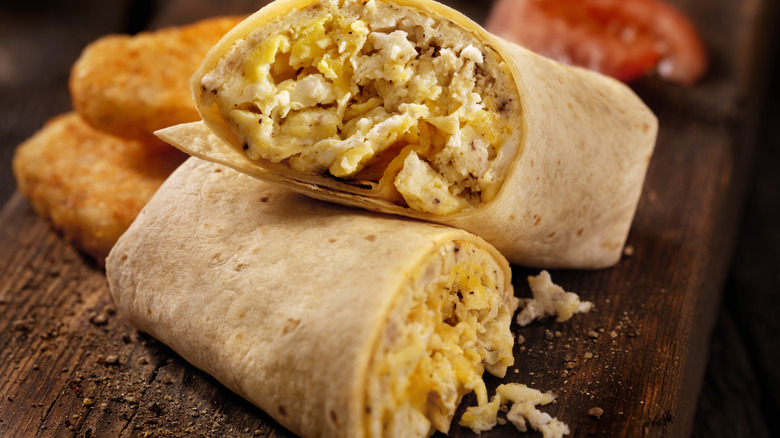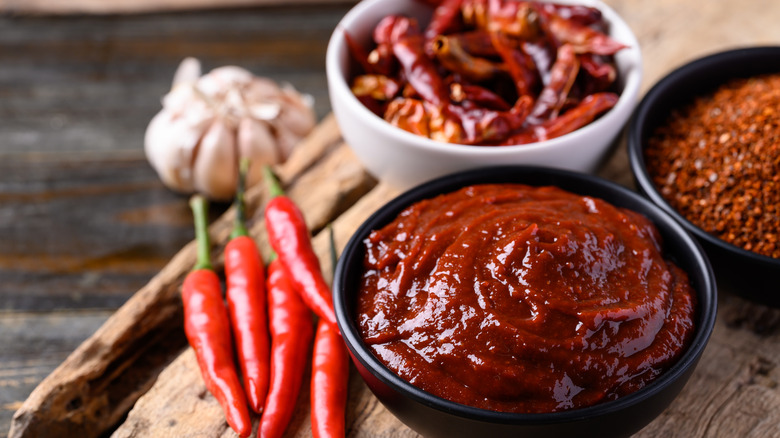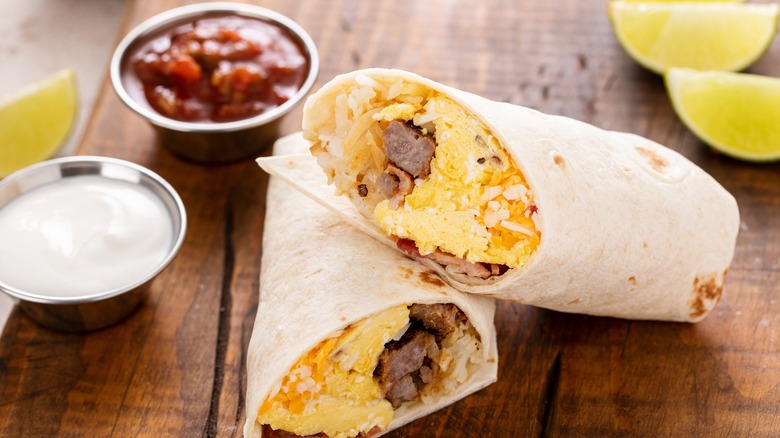Give Breakfast Burritos A Serious Flavor Upgrade Using Gochujang
All praise to the versatile breakfast burrito. Whether handmade, frozen, or from a heated deli counter, it checks all the morning boxes: salt, fatty protein, eggs, carbs, a synergy of portability and deliciousness. It's amazing hangover food that can be made as simple or as experimental as you like. Our ultimate breakfast burrito recipe includes all the fixings, including avocado, egg, sausage and hash browns. But one thing these tortilla-bound bundles of joy can sometimes lack when set down in front of you is heat (as in something spicy, with a kick).
It's pretty common to add a few dashes of Tabasco or your favorite hot sauce atop each bite, and that works well enough. Tossing in diced jalapeño with the eggs or topping with salsa is also a nice touch. But if you really want to kick things into high gear flavor-wise, set your sights on Korea's gochujang paste. Spicy, smoky, and sweet all in one texturally pleasing spoonful, this is the ingredient you never knew was missing in breakfast burritos.
Why gochujang works as a burrito ingredient
Gochujang is a red chile paste that originated in Korea centuries ago and is a core ingredient for meat marinades in traditional dishes like bulgogi and bibimbap. While many hot sauces involve powdered or crushed chile peppers suspended in vinegar or oil, gochujang is different. The primary ingredients are red pepper flakes or powder, meju (fermented soybean), and glutinous (sticky) rice powder, along with salt and other seasonings.
Depending on the proportions of each and how long the ingredients ferment, the paste will trend more spicy, savory/umami, or sweet. This complex flavor profile lends itself beautifully to a number of foods. It's a key ingredient in celebrity chef David Chang's favorite canned tuna (Dongwon Tuna With Hot Pepper Sauce). You can blend it into a roux as a base to seriously upgrade mac and cheese. With breakfast burritos, the spice cuts through the egg and meat fats, while the earthy sweetness enhances potatoes. Those umami notes complement bacon or sausage and contrast against the mild flour tortilla. It truly is a game changer, elevating a simple morning indulgence to something akin in complexity to chilaquiles or huevos rancheros.
How to use gochujang in breakfast burritos
Though there are several gochujang chile sauces on the market, it's most commonly found as a moderately thick paste, roughly the consistency of canned tomato paste or harissa. As a result, it's best to consider it an ingredient rather than a condiment (it doesn't work particularly well to slap a dollop on top of the burrito and bite in). The easiest way to incorporate the paste is as a smear along the length of the tortilla as you're building the burrito. You don't need a lot, perhaps a teaspoon or less, to enjoy the full flavor.
Another option is to mix it into the eggs, either when scrambling or during cooking. Again aim for a teaspoon or less, to taste, and make certain it's fully mixed in. This method ensures you're distributing the sauce throughout the eggs, and hence in each burrito bite. (if you have the time, you could make a marinade for any proteins, a popular method for seasoning stew meats in Korean cuisine).
If it's a sauce you seek, consider mixing gochujang with hot sauce, Sriracha, mayonnaise or other condiments. Not only does it allow you to craft something you can drizzle, dash, or dip into, but you can customize it as much as you like. A hint will upgrade your favorite spicy ketchup, while mixing mayo into gochujang creates a spicy-creamy special sauce perfect not only for breakfast burritos, but burgers, pizza, fries, or tuna fish sandwiches.


